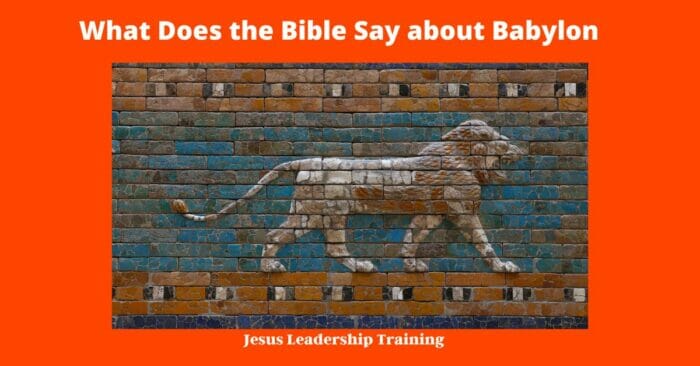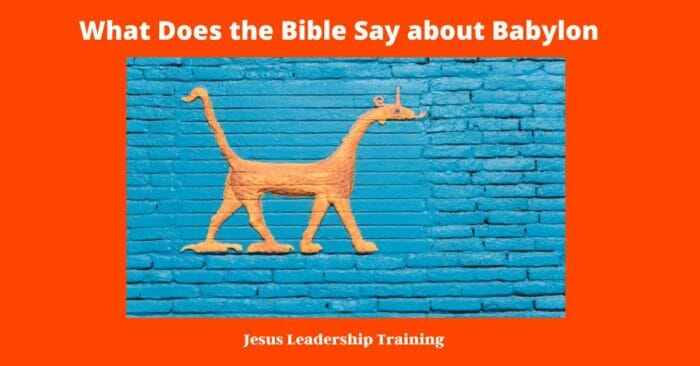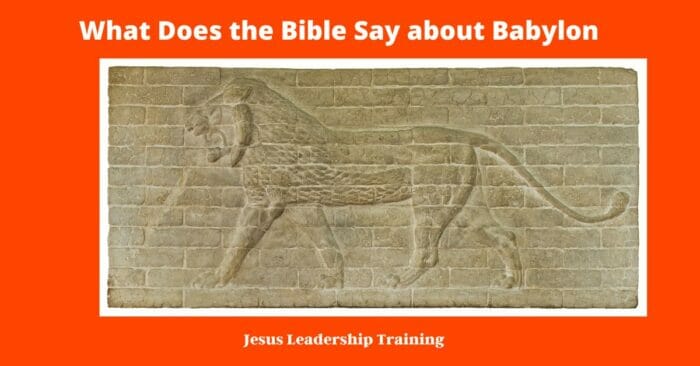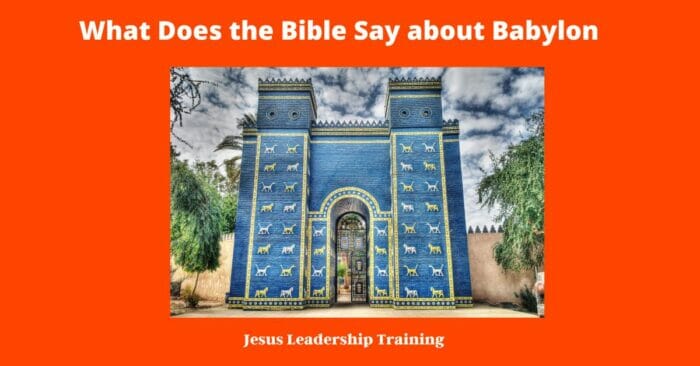What Does the Bible Say about Babylon – The Bible references Babylon in numerous books, from the Old Testament to the New Testament. Babylon is a city that has been known throughout history as a powerful city and a symbol of the world’s evil. In the Bible, Babylon is seen as a symbol of opposition to God and the power of sin, and the consequences of rebellion against God’s will.
The Bible speaks of Babylon in terms of judgment and destruction, but also in terms of hope and redemption. In the Old Testament, Babylon is seen as an oppressive regime meant to punish God’s people for their sins. In the New Testament, Babylon is often used as a symbol for the Roman Empire and its opposition to the gospel message.
Table of Contents
What Does the Bible Say about Babylon
The Bible is a collection of books written by ancient prophets and reveals the history of the world, the life of Jesus Christ, and the plan of salvation. It is a record of God’s dealings with mankind and is an invaluable source of spiritual guidance. Throughout the Bible, there are numerous references to the city of Babylon. From the time of Abraham to the fall of the Babylonian Empire, Babylon is a major part of the narrative. This blog will explore what the Bible says about Babylon and its importance in biblical history.
Bible Verses about Babylon
History of Babylon in the Bible
Babylon is mentioned in the Bible more than any other city. Its origin is shrouded in mystery, but it is believed to have been built around 2200 BC, by a man named Nimrod. In the book of Genesis, Babylon is referenced for the first time, during the story of the Tower of Babel. This is where the people of the land attempted to build a tower that would reach the heavens. God punished their pride by scattering them across the earth and confusing their language, making it impossible for them to work together.
- The Tower of Babel is a structure featured in the Book of Genesis in the Bible. According to the book, it was a tower built by a united humanity meant to reach the heavens.
- The Tower of Babel was located in the city of Babylon, which is now located in modern-day Iraq.
- According to the Bible, the tower was built as an act of defiance by mankind against God.
- It is believed that the Tower of Babel was built using mud bricks and was around 300 feet high.
- The Tower of Babel is believed to be the first example of a ziggurat, which is a type of stepped pyramid structure.
- According to the Bible, God punished the people for their attempt to reach the heavens by making them speak different languages, thus leading to the downfall of the Tower of Babel.
- The Tower of Babel is often used as a symbol of mankind’s futile attempts to reach the heavens.
- The Tower of Babel is often depicted in art and literature, most famously in Pieter Bruegel’s famous painting from 1563.
- In the 21st century, the Tower of Babel has become an important symbol of the power of language, and how it can be both a unifying and divisive force.
- The Tower of Babel is an important part of the cultural heritage of many societies throughout the world, and it continues to inspire people to this day.

List of Kings that Ruled Babylon
- Hammurabi (1792 BC – 1750 BC): Hammurabi was the first king of Babylon and is known for his law code which was one of the oldest in recorded history. He was responsible for bringing prosperity to Babylon and making it one of the most powerful cities in the ancient world. He also established the city as the religious capital of Mesopotamia.
- Samsu-iluna (1750 BC – 1712 BC): He was the son of Hammurabi and is known for his expansion of Babylon’s borders. He also conquered lands from the Assyrians and Elamites and brought them under Babylonian control. He was an effective ruler and strengthened the city’s military forces.
- Abi-Eshuh (1712 BC – 1684 BC): He was the son of Samsu-iluna and is known for his religious reforms. He established new temples and reorganized the priesthood in Babylon. He also encouraged the worship of Marduk, the patron deity of Babylon.
- Ammi-Ditana (1684 BC – 1647 BC): He was the son of Abi-Eshuh and is known for his construction of new temples and monuments in Babylon. He also attempted to expand Babylon’s influence and control over other cities.
- Ammi-Saduqa (1647 BC – 1626 BC): He was the son of Ammi-Ditana and is known for his efforts to restore the city’s religious and cultural life. He also attempted to expand Babylon’s control over other cities but was unsuccessful.
- Samsu-Ditana (1626 BC – 1595 BC): He was the son of Ammi-Saduqa and is known for his military campaigns and successful expansion of Babylon’s borders. He also established diplomatic relationships with other powers in the region.
- Samsu-Muballit (1595 BC – 1531 BC): He was the son of Samsu-Ditana and is known for his military campaigns against the Hittites, Assyrians and Elamites. He also established diplomatic relationships with other powers in the region.
- Marduk-apla-iddina I (1531 BC – 1482 BC): He was the son of Samsu-Muballit and is known for his successful expansion of Babylon’s borders and its military strength. He also established Babylon as the religious capital of Mesopotamia.
- Marduk-shapik-zeri (1482 BC – 1450 BC): He was the son of Marduk-apla-iddina I and is known for his successful military campaigns against the Assyrians and Elamites. He also established Babylon as a major trading center in the region.
- Marduk-nadin-ahhe (1450 BC – 1412 BC): He was the son of Marduk-shapik-zeri and is known for his successful campaigns against the Assyrians and Elamites. He also established Babylon as a major cultural and religious hub in the region.

King James Version and Babylon
The King James Bible was translated from the Hebrew and Greek texts in 1611 and is still considered the most accurate translation of the Bible today. In the King James Version of the Bible, Babylon is mentioned more than 300 times. The city is referred to as a symbol of rebellion against God, a place of captivity, and a place of spiritual death. In the book of Revelation, Babylon is also seen as a symbol of the devil and his kingdom of darkness.
King Nebuchadnezzar and Babylon
The most well-known ruler of Babylon was King Nebuchadnezzar. He is mentioned in the Bible several times, including in the book of Daniel. King Nebuchadnezzar is known for conquering the city of Jerusalem and taking the Jews captive to Babylon. It was during this time that the Jews were forced to live in exile for 70 years. This experience is often used as a reminder of God’s faithfulness and His promise to protect His people.
- King Nebuchadnezzar II (634–562 BC) was the most famous and powerful ruler of Babylon, an ancient Mesopotamian city-state located in what is now Iraq. He is best known for his conquest of Jerusalem and the destruction of the First Temple of the Hebrews in 587 BC.
- During his reign, King Nebuchadnezzar II built the Hanging Gardens of Babylon, one of the Seven Wonders of the Ancient World.
- He also constructed the Ishtar Gate, a grand entrance to the city of Babylon, which was decorated with blue glazed bricks and images of bulls and dragons.
- King Nebuchadnezzar II is credited with the creation of the Babylonian system of law, which was the first written code of laws in the world.
- He is also believed to have created the world’s first postal system and introduced the first coinage.
- King Nebuchadnezzar II is thought to have been the first ruler to issue an edict requiring all his subjects to learn the Akkadian language.
- He was a great military conqueror, leading numerous campaigns throughout the Middle East and expanding Babylon’s borders to include parts of modern-day Syria, Lebanon, and Israel.
- King Nebuchadnezzar II was an astute administrator and is credited with unifying the disparate cultures of the Middle East.
- He was a patron of the arts and literature, and Babylonian literature flourished during his reign.
- He is also remembered for his religious tolerance and is believed to have allowed the Hebrews to practice their religion while living in Babylon.

Babylon’s Rivers in the Bible
Babylon was known for its rivers, which were often referred to in the Bible. The Euphrates and Tigris Rivers both ran through Babylon and were essential to the city’s trade. The book of Revelation mentions the Euphrates river drying up, which is seen as a symbol of the destruction of Babylon.
- The Euphrates and Tigris Rivers are two of the longest rivers in the Middle East, stretching from the mountains of Turkey, through Iraq, and into the Persian Gulf.
- The two rivers are the most important rivers in the region, providing water for a large part of the population, as well as irrigation and hydroelectric power.
- The two rivers are historically significant, as the area between them was known as Mesopotamia, and is considered to be the cradle of civilization.
- The Euphrates is the longest of the two rivers, stretching 1,700 miles (2,730 km) from the mountains of Turkey to the Persian Gulf.
- The Tigris is the second longest, at 1,150 miles (1,850 km).
- The two rivers meet at the ancient city of Basra, Iraq.
- The rivers are fed by numerous tributaries, including the Karun and Karkheh Rivers in Iran, the Khabur and Balikh Rivers in Syria, and the Diyala and Great Zab Rivers in Iraq.
- The Euphrates and Tigris Rivers are home to a wide variety of fish, including carp, catfish, and eel.
- The two rivers are also home to a wide variety of migratory birds, including ducks, geese, and herons.
- The Euphrates and Tigris Rivers are at risk from overuse and pollution, as much of the surrounding area is heavily industrialized and agricultural.

Sins of Babylon in the Bible
Throughout the Bible, Babylon is seen as a wicked and sinful city. It is often referred to as an “evil city” and its sins are used to illustrate the consequences of turning away from God. In the book of Isaiah, Babylon is described as a place of “violence, crime, and deceit” where people “have no regard for truth.”
Will God Destroy Babylon?
The Bible is clear that God will eventually bring judgment upon Babylon. In the book of Revelation, the destruction of Babylon is described in vivid detail. It is seen as a mighty city that will fall at the hands of God’s wrath. The fall of Babylon is seen as a symbol of the end of the world and the coming of God’s kingdom.
Babylon’s Spiritual Meaning in the Bible
In addition to its physical destruction, Babylon also has a spiritual meaning in the Bible. It is seen as a symbol of pride and rebellion against God. The city is often used to illustrate the consequences of turning away from God and trusting in the world’s false promises.
Symbolic Representation of Babylon in the Bible
Babylon is often used as a symbol in the Bible. It is seen as a place of captivity and a symbol of God’s judgment. In the book of Revelation, Babylon is used to represent the devil and his kingdom of darkness. It is seen as a place of spiritual death and a reminder of the ultimate destruction of all wickedness.
Babylon’s Role in the Old Testament
Throughout the Bible, Babylon is seen as a major part of Old Testament history. In the book of Genesis, it is seen as a place of pride and rebellion against God. In the book of Daniel, Babylon is used to illustrate God’s faithfulness and His promise to protect His people. In the book of Isaiah, Babylon is seen as a place of violence and wickedness, and in the book of Revelation, it is seen as a symbol of the coming judgment of God.
- Babylon was an ancient city located in present-day Iraq and was one of the most important cities in the ancient world. It was the capital of the Neo-Babylonian Empire, which was the most powerful empire in the Middle East from 626 to 539 BCE.
- Babylon was a major center of learning and culture during its peak, and it was known for its impressive architecture, including the famous Hanging Gardens of Babylon.
- The Jews had a long history with Babylon and were a major part of the population during the Neo-Babylonian period.
- The Babylonian Captivity is a significant part of Jewish history, as the Babylonians conquered Israel in 586 BCE and forced many of the Jews into exile in Babylon.
- During the Babylonian Captivity, the Babylonians destroyed the Temple of Jerusalem and took many of the Jews’ valuables and possessions.
- The Babylonians also forced the Jews to learn the Babylonian language and adopt many of their customs and traditions.
- During the Babylonian Captivity, many of the Jews began to adopt the Babylonian religion, which eventually led to the development of the modern Jewish faith.
- The Babylonians were also responsible for the creation of the Talmud, a collection of Jewish laws and teachings that would become the basis for modern Judaism.
- After the Babylonians were defeated by the Persians in 539 BCE, the Jews were allowed to return to their homeland and rebuild the Temple of Jerusalem.
- The Babylonian Exile is still commemorated by the Jewish people today in the festival of Tisha B’Av, which marks the destruction of the Temple in Jerusalem.
How Babylon is Referenced in the Bible
Throughout the Bible, Babylon is referenced in many different ways. In the Old Testament, it is seen as a place of captivity and oppression. In the New Testament, it is seen as a symbol of spiritual death and ultimate destruction. In the book of Revelation, Babylon is used to represent the devil and his kingdom of darkness.
The Fall of Babylon in the Bible
The fall of Babylon is mentioned several times in the Bible. In the book of Isaiah, it is seen as a punishment for the nation’s pride and rebellion against God. In the book of Revelation, it is seen as a symbol of the destruction of the world and the coming of God’s kingdom.
Empires that Ruled Babylon
Throughout its long history, Babylon was ruled by several different empires. The most well-known rulers of Babylon were the Babylonians, who built the city around 2200 BC. Other empires that ruled Babylon include the Assyrians, the Persians, the Greeks, and the Romans.
The Punishment of Babylon in the Bible
In the Bible, the punishment of Babylon is seen as a symbol of God’s judgment. In the book of Isaiah, Babylon is described as a place of violence and wickedness, and God promises to judge and punish the city. In the book of Revelation, Babylon is seen as a symbol of spiritual death and ultimate destruction.
Babylon as a Symbol of Rebellion in the Bible
Throughout the Bible, Babylon is seen as a symbol of rebellion against God. In the book of Isaiah, Babylon is described as a place of pride and sin, and the punishment of Babylon is seen as a reminder of the consequences of turning away from God. In the book of Revelation, Babylon is used to represent the devil and his kingdom of darkness.
Final Thoughts – What Does the Bible Say about Babylon
The city of Babylon is mentioned in the Bible more than any other city. It is a major part of Old Testament history and is used as a symbol of rebellion against God. The fall of Babylon is seen as a symbol of the end of the world and the coming of God’s kingdom. In the Bible, Babylon is seen as a place of captivity, spiritual death, and ultimate destruction. The city of Babylon is an important part of biblical history and its story is a reminder of God’s faithfulness and His promise to protect His people.




